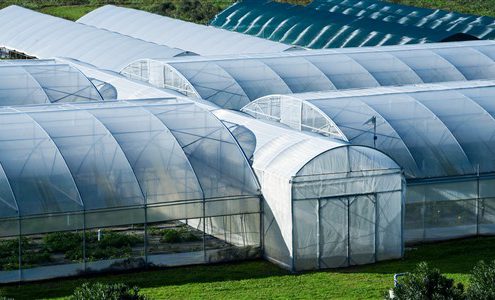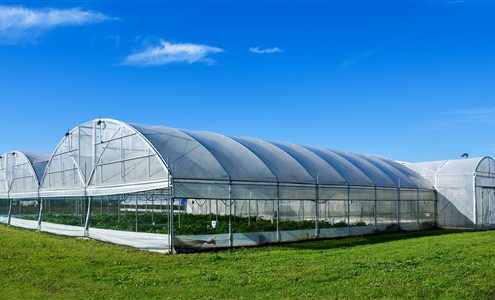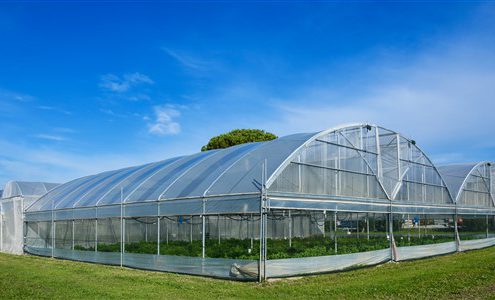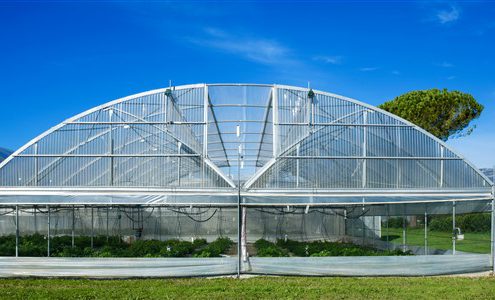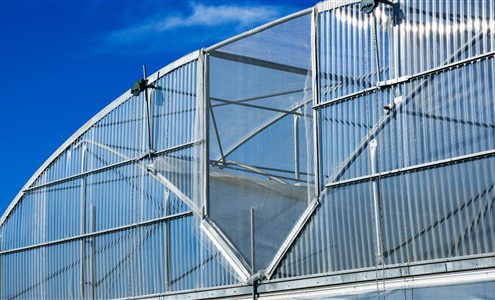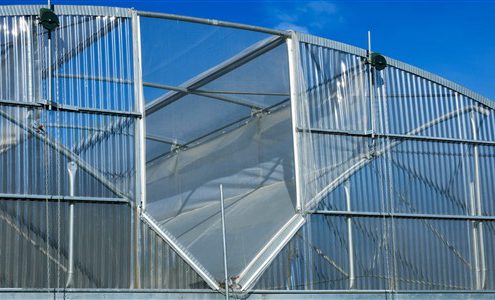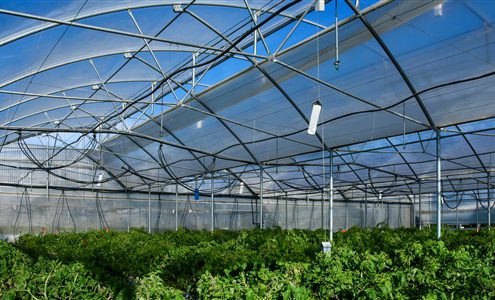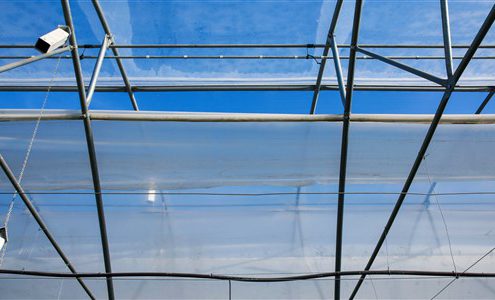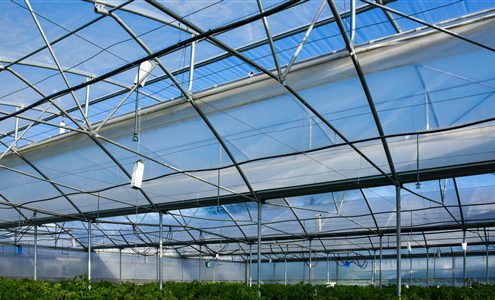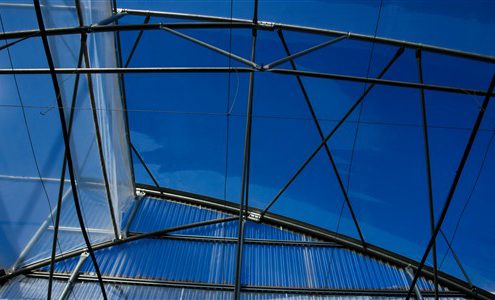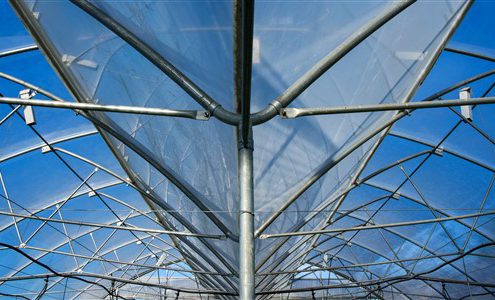Greenhouse SVN – PATENTED
The greenhouse with natural ventilation “SVN” originates from the collaboration between Opus et Vita and CREA, a research center for horticolture.
The innovative features of greenhouse SVN were recognized with the patent no. 0001418118.
Why the greenhouse SVN?
The greenhouse SVN is adapted particularly, though not exclusively, to be applied to cultivations of agricultural products in the area of Mediterranean where the climate conditions make not suitable and cost-effective the adoption of active and highly technological greenhouses.
The aim of the invention of this new concept of greenhouse was to provide a structure:
- with contained costs for building and management, where the natural ventilation, shown to be the most powerful and cost-effective tool for conditioning the internal microclimate, takes place in a natural and efficient way;
- that allows a stable and efficient installation of anti-insect nets in order to permit a large use of biological fight, thus allowing to offer horticultural products with high hygienic-sanitary safety and being more competitive on the market.
The innovation of greenhouse SVN
The real point of strenghts of the greenhouse SVN are:
- the particular ventilation system that allows that the ventilation enclosed within the greenhouse takes place in a natural way, without the need for automation devices arranged, for example, for the opening/closing of the greenhouse rooftop;
- the system for the stable installation of anti-insect nets, that allows to make the greenhouse sealed with regard to the entrance of insects aggressive toward crops and to reduce or avoid the use of phytochemicals.
The ventilation system
The real innovation of greenhouse is represented by the new ventilation system and, in particular, by the rooftop opening that follows the profile of the structure and allows:
- to ensure a stable performance in terms of ventilation rate, which will only depend on the wind speed and not on the wind direction;
- high safety with respect to damages that can be caused by wind (the inner profile of the greenhouse allows to keep the rooftop open also in the presence of unfavorable meteorological events without the need for monitoring or sensors).
The anti-insect nets
The greenhouse is always tightly protected against the entrance of insects, allowing the permanent installation of anti-insect nets on:
- the rooftop opening;
- the perimetral openings;
- the passageway corridors.
The system for closing passageway corridors between adjacent greenhouse bodies allows to obtain a significant improvement in the accessibility to the inside of the greenhouse and in the tightness of the whole.
Advantages of greenhouse SVN
- Reduced costs for the construction and O&M of the greenhouse and maximum cost-benefit ratio.
- Maximization of the natural ventilation notwithstanding the stable installation of anti-isect nets.
- Possibility of permanently install anti-insect nets making possible the biological fight against the damaging insects toward the crops.
- Fixed configuration of greenhouse which does not require alterations in case of unfavorable climatic events and the need of automation systems for the safety operation of the openings.
- High Volume/Surface ratio, that avoids sudden change of inner temperature of the greenhouse.
Main dimensional parameters
Width of the span: 16 m (2×8 m)
- Lenght: variable
- Distance between columns: 2,5 m
- Gutter height: 2,45-2,7 m
- Total height: 5,3-5,55 m
- Rooftop opening width: 2 m
- Opening surface/Covered surface: >20%
The Opening surface/Covered surface ratio is equal to 20% in the worst configuration (1 hectar greenhouse with a square floor plan). The suggested layout in order to optimize the natural ventilation is a greenhouse with a covered surface of about 2500 sqm and a maximum lenght of 40 m.
The structure
All the structural members of the greenhouses are made of galvanized steel according to international standard as applicable, joined by members studied in detail to ensure maximum strength, ease of assembly and simplified installation of additional equipment.
Columns: hollow circular section Ø 60 mm, thickness 2 mm, hot dip galvanized,
Archs: hollow circular section Ø 60 mm, thickness 1,5 mm, Sendzimir (Z 275) galvanized.
Truss: the arch is reinforced by a truss made by the following elements, joined by high resistance members:
- tie-beam (two pieces): hollow circular section Ø 33 mm, thickness 1,5 mm, Sendzimir (Z 275) galvanized;
- rods (No. 2): hollow circular section Ø 33 mm, thickness 1,5 mm, Sendzimir (Z 275) galvanized.
Ridge connection: hollow circular section Ø 33 mm, thickness 1,5 mm, Sendzimir (Z 275) galvanized.
Column bracings (“St Andrew’s Cross” bracings): hollow circular section Ø 33 mm, thickness 1,5 mm, Sendzimir (Z 275) galvanized.
Drainage gutter: thickness 1,2 mm, Sendzimir galvanized, with a high water removal capacity. Each gutter is supplied with end drainage outlets to which Ø140 mm drainage pipes can be connected and end cap.
Cladding materials
Roof
Plastic film
Anti-insect net
Side and end walls
Plastic film
Anti-insect net
Fiberglass (baseboard)
Polycarbonate (gable ends)
The anchor system
The ground anchor system used for building the greenhouse is with screwpiles.
The use of this system depends on the characteristics of soil of building site.

